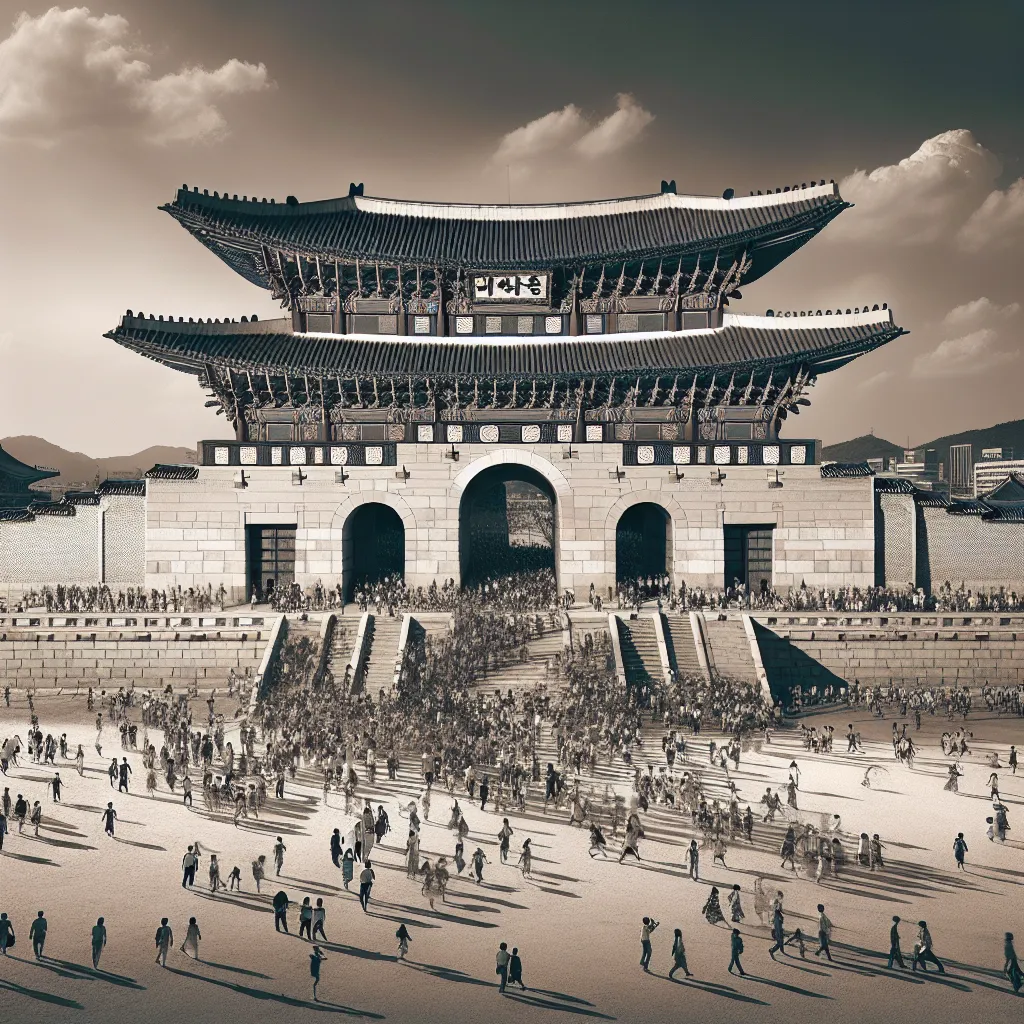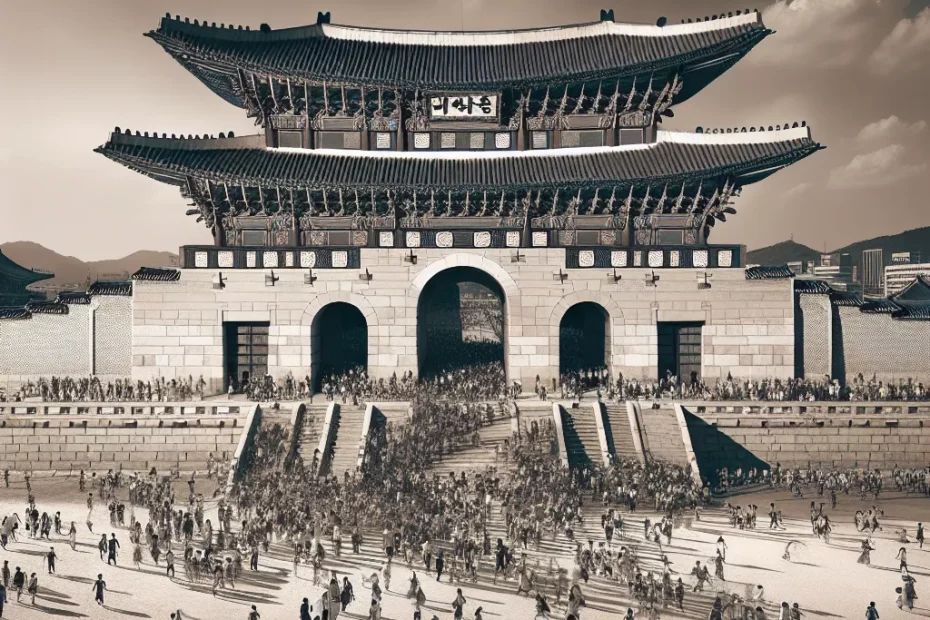Gwanghwamun Gate stands as a testament to Korea’s resilience and endurance throughout its rich history. As a symbol of Korean identity, this architectural marvel has witnessed centuries of triumphs and challenges. The historical significance of Gwanghwamun Gate cannot be understated, serving as a reminder of Korea’s cultural heritage and national pride. Thanks to ongoing renovations and preservation efforts, this iconic landmark continues to inspire awe and admiration from visitors around the world.

The Symbol of Korean History and Identity
Gwanghwamun Gate stands as a testament to Korea’s resilience and endurance throughout its rich history. This iconic landmark, located in the heart of Seoul, has witnessed the rise and fall of dynasties, the struggles for independence, and the modernization of the nation. With its majestic presence and historical significance, Gwanghwamun Gate symbolizes the spirit and identity of the Korean people.
A Beacon of History
Gwanghwamun Gate, originally built in 1395 during the Joseon Dynasty, served as the main entrance to Gyeongbokgung Palace, the royal residence. It has survived numerous invasions, wars, and even destruction, only to be rebuilt and restored time and time again. This resilience in the face of adversity reflects the indomitable spirit of the Korean people.
Cultural Identity
The gate is not just a physical structure but a symbol of Korean culture and identity. It represents the values of tradition, honor, and pride that have been passed down through generations. The intricate architectural design and the grandeur of the gate reflect the sophistication and artistry of Korean craftsmanship.
Historical Significance
Throughout history, Gwanghwamun Gate has been a witness to pivotal moments in Korea’s past. From the proclamation of the Korean Empire in 1897 to the March 1st Movement for independence in 1919, the gate has been at the center of many historical events that shaped the nation.
A Living Monument
Today, Gwanghwamun Gate continues to be a symbol of national pride and unity. It is a popular tourist attraction and a gathering place for celebrations and protests alike. The gate serves as a reminder of Korea’s past struggles and achievements, inspiring future generations to uphold the values of perseverance and strength.
Celebrating Heritage
Every year, on National Foundation Day, a grand ceremony takes place at Gwanghwamun Gate to honor Korea’s cultural heritage and history. The solemn rituals and colorful performances showcase the deep-rooted traditions that have been preserved for centuries.
In conclusion, Gwanghwamun Gate stands as more than just a physical structure; it is a living symbol of Korean history and identity. As a beacon of resilience and endurance, it reminds us of the challenges overcome and the victories achieved throughout the nation’s storied past. Gwanghwamun Gate will continue to stand tall, bearing witness to Korea’s journey towards a brighter future.
Architectural Marvel of Gwanghwamun Gate
Behold the magnificent Gwanghwamun Gate, a true testament to Korea’s rich history and architectural prowess! This iconic structure stands proudly in the heart of Seoul, serving as a symbol of resilience and endurance throughout the ages. 🏛️
The History of Gwanghwamun Gate
Constructed in 1395 during the Joseon Dynasty, Gwanghwamun Gate has withstood the test of time, bearing witness to centuries of political upheavals, invasions, and modernization. The gate, along with the adjoining walls, stretches an impressive 555 meters in length, showcasing the meticulous craftsmanship and strategic design of its builders. 🏰
Architectural Details
The gate’s intricate architectural details, including the elegant eaves, colorful paintings, and ornate decorations, reflect the artistic sophistication of the Joseon era. Each element serves a symbolic purpose, from the mythical creatures adorning the roof to the intricate patterns adorning the wooden doors. 🎨
Historical Significance
Not only is Gwanghwamun Gate a visual masterpiece, but it also holds great historical significance. It served as the main entrance to Gyeongbokgung Palace, the primary royal residence during the Joseon Dynasty. The gate’s strategic location at the northern end of Seoul’s main thoroughfare, Sejongno, highlights its importance as a symbol of power and authority. 👑
Restoration and Legacy
Despite facing numerous challenges, including destruction during the Japanese occupation in the early 20th century, Gwanghwamun Gate has been meticulously restored to its former glory, showcasing Korea’s commitment to preserving its cultural heritage. Today, it stands as a beloved landmark and a source of national pride, attracting visitors from around the world to marvel at its beauty and historical significance. 🌏
In conclusion, Gwanghwamun Gate stands as a shining example of Korea’s architectural excellence and unwavering spirit. Its timeless beauty and historical significance continue to inspire awe and admiration, making it a must-visit destination for anyone seeking to experience the rich cultural heritage of Korea. 🌟
Historical Significance of Gwanghwamun Gate
The Gwanghwamun Gate stands as a symbol of Korea’s resilience and endurance throughout its rich history. Built during the Joseon Dynasty in 1395, this majestic gate has witnessed centuries of triumphs and challenges, making it a true testament to the spirit of the Korean people. 🏯
Symbol of Power and Authority
As the main gate of Gyeongbokgung Palace, the Gwanghwamun Gate served as the primary entrance to the royal palace, signifying power and authority. Its intricate architectural design, with its double-tiered roof and towering wooden pillars, reflects the grandeur and sophistication of the Joseon Dynasty. 🌟
Resilience in the Face of Adversity
During the Japanese invasion of Korea in the late 16th century, the Gwanghwamun Gate was destroyed along with much of the palace. However, it was rebuilt in the 19th century and has since stood as a symbol of Korea’s ability to rise from adversity. The gate’s reconstruction represents the resilience of the Korean people in the face of adversity and their commitment to preserving their cultural heritage. 💪
Beacon of Hope
Throughout Korea’s turbulent history, the Gwanghwamun Gate has been a silent witness to significant events, including the Japanese colonial rule and the Korean War. Despite facing numerous challenges, the gate has remained standing, a beacon of hope and a reminder of Korea’s enduring spirit. 🕊️
Cultural and Historical Significance
Today, the Gwanghwamun Gate continues to hold immense cultural and historical significance for the Korean people. It serves as a reminder of Korea’s rich heritage and the sacrifices made by past generations to preserve their identity. Visiting the Gwanghwamun Gate is not just a journey through history but a tribute to the strength and resilience of the Korean nation. 🇰🇷
In conclusion, the Gwanghwamun Gate stands as a symbol of Korea’s resilience, endurance, and unwavering spirit throughout its tumultuous history. It is a testament to the strength of the Korean people and a reminder of the importance of preserving cultural heritage in the face of adversity. The gate’s historical significance cannot be understated, as it continues to inspire generations with its timeless beauty and profound symbolism. ✨
Renovations and Preservation Efforts
In the realm of historical preservation, the efforts to uphold the grandeur and significance of Gwanghwamun Gate stand as a testament to Korea’s dedication to its cultural heritage. The meticulous renovations carried out on this iconic structure have not only revitalized its physical appearance but also breathed new life into its historical narrative. 🏛️
The Importance of Preservation
Over the years, a substantial amount of resources, both financial and intellectual, have been invested in the preservation of Gwanghwamun Gate. The meticulous attention to detail in the restoration process is evident in every inch of the gate, from the intricate carvings on the wooden doors to the majestic stone foundations that have withstood the test of time. 🌟
Utilization of Advanced Techniques
Moreover, the utilization of advanced preservation techniques and technologies has ensured that Gwanghwamun Gate retains its authenticity while safeguarding it against the natural elements and the passage of time. The integration of modern materials with traditional craftsmanship has not only enhanced the gate’s structural integrity but has also prolonged its lifespan for future generations to marvel at. 🕰️
Symbol of Resilience
The commitment to preserving Gwanghwamun Gate extends beyond mere physical restoration. It encompasses a deep-rooted respect for the historical and cultural significance that this iconic landmark holds in the hearts of the Korean people. The gate serves as a symbol of resilience and endurance, a living testament to Korea’s rich and storied past. 🌿
As we stand in awe of Gwanghwamun Gate today, we are not just witnessing a structure that has withstood the ravages of time; we are bearing witness to the unwavering spirit of a nation that continues to cherish and protect its heritage with unwavering dedication. Let us continue to celebrate and preserve the legacy of Gwanghwamun Gate for generations to come. 🌺
Throughout its long history, Gwanghwamun Gate has stood as a symbol of Korea’s resilience and endurance. As a witness to the country’s triumphs and challenges, it embodies the spirit of the Korean people. The architectural marvel of the gate showcases the ingenuity and craftsmanship of the past, while its historical significance reminds us of the rich cultural heritage that defines Korea. The ongoing renovations and preservation efforts ensure that future generations can continue to appreciate and learn from this iconic landmark. Gwanghwamun Gate stands not just as a physical structure, but as a testament to Korea’s unwavering spirit and commitment to preserving its history.
